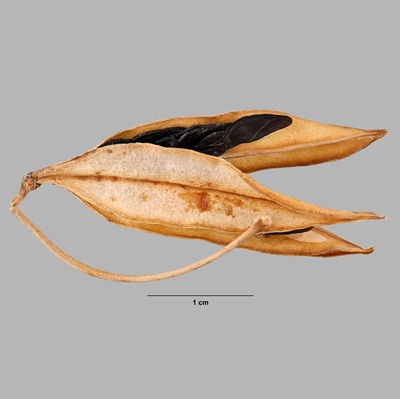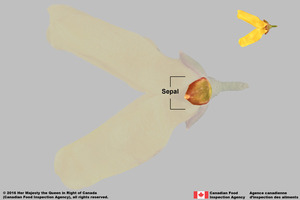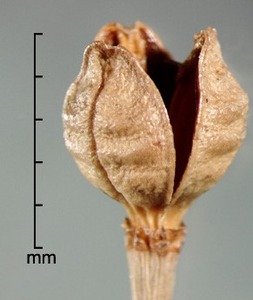Fruit form or type can be an important consideration for identification, yet it can be difficult to interpret, especially for novice botanists. Fruits either open at maturity (dehiscent) to release seeds or they do not (indehiscent). Contaminants may be encountered as mature fruits or immature, whole fruits with or without seeds, fragments of fruits with or without seeds, or just seeds. Due to the variety of forms contaminants may take, the key does not focus on fruit type. However, it is worth keeping in mind, when comparing a specimen to the fruit types listed in a family fact sheet, that, for instance, an immature capsulecapsule:
a dry, dehiscent fruit formed by two or more carpels
 may look similar to a dried berryberry:
may look similar to a dried berryberry:
an indehiscent, fleshy fruit with one or a few to many seeds. The flesh may be homogenous throughout. Or, if the outer part is hard, firm, or leathery, referred to as an hesperidium. Septa are present in some, and the seeds may be arillate or with a fleshy testa. . When possible, images of immature fruits are also included in the fact sheets.
. When possible, images of immature fruits are also included in the fact sheets.
As contaminants, fleshyfleshy:
texture—fairly firm and dense, juicy or at least moist, and easily cut
, indehiscentindehiscent:
not opening on its own, as in a fruit
 fruits, such as berriesberry:
fruits, such as berriesberry:
an indehiscent, fleshy fruit with one or a few to many seeds. The flesh may be homogenous throughout. Or, if the outer part is hard, firm, or leathery, referred to as an hesperidium. Septa are present in some, and the seeds may be arillate or with a fleshy testa. or drupesdrupe:
or drupesdrupe:
(indehiscent drupe) a fleshy, indehiscent fruit with one more hard pits enclosing seeds; (dehiscent drupe) a fruit with a dry or fibrous to fleshy or leathery outer husk that early to tardily breaks apart (or opens), exposing one or more nutlike pits enclosing the seeds
 , usually appear shriveled, often with a thinthin:
, usually appear shriveled, often with a thinthin:
having or being of relatively little depth
outer fruit wall and a dried fleshyfleshy:
texture—fairly firm and dense, juicy or at least moist, and easily cut
inner wall. BerriesBerry:
an indehiscent, fleshy fruit with one or a few to many seeds. The flesh may be homogenous throughout. Or, if the outer part is hard, firm, or leathery, referred to as an hesperidium. Septa are present in some, and the seeds may be arillate or with a fleshy testa. are several- to many-seeded, while drupesdrupe:
are several- to many-seeded, while drupesdrupe:
(indehiscent drupe) a fleshy, indehiscent fruit with one more hard pits enclosing seeds; (dehiscent drupe) a fruit with a dry or fibrous to fleshy or leathery outer husk that early to tardily breaks apart (or opens), exposing one or more nutlike pits enclosing the seeds
 have a stony pit(s) encasing a seed(s).
have a stony pit(s) encasing a seed(s).
Most drydry:
texture—free or relatively free from water or liquid
, indehiscentindehiscent:
not opening on its own, as in a fruit
 fruit types are single-seeded and are often difficult to distinguish from seeds. In fact, these fruits are often casually referred to as “seeds” or “seed units”. For these types of specimens, recognizing if they are seeds or single-seeded fruits, and then, what type of single-seeded fruit, will help in choosing between families. The presence of an easily removed fruit wall revealing the seed inside or accessory structures, such as persistent bracts, scales, tufts of hairs, or wings, may help distinguish fruits from seeds. Even though wings and hairs occur on seeds, they are more frequently found on fruits, since accessory structures usually develop from floral parts. The easiest to recognize (and most common) accessory structures are persistent sepalssepal:
fruit types are single-seeded and are often difficult to distinguish from seeds. In fact, these fruits are often casually referred to as “seeds” or “seed units”. For these types of specimens, recognizing if they are seeds or single-seeded fruits, and then, what type of single-seeded fruit, will help in choosing between families. The presence of an easily removed fruit wall revealing the seed inside or accessory structures, such as persistent bracts, scales, tufts of hairs, or wings, may help distinguish fruits from seeds. Even though wings and hairs occur on seeds, they are more frequently found on fruits, since accessory structures usually develop from floral parts. The easiest to recognize (and most common) accessory structures are persistent sepalssepal:
a member of the outer envelope of a flower (calyx)
 (calyx) or petalspetal:
(calyx) or petalspetal:
a member of the inner envelope of a flower (corolla) (corolla) or both (perianth). Sometimes, persistent perianthsperianth:
(corolla) or both (perianth). Sometimes, persistent perianthsperianth:
collective term for calyx and corolla of a flower
 can be strongly adherent, as in the case of some Polygonaceae fruits. Inspecting a specimen under 10x to 20x magnification will assist in determining if it has accessory structures.
can be strongly adherent, as in the case of some Polygonaceae fruits. Inspecting a specimen under 10x to 20x magnification will assist in determining if it has accessory structures.
Some of the most commonly intercepted drydry:
texture—free or relatively free from water or liquid
, single-seeded, indehiscentindehiscent:
not opening on its own, as in a fruit
 fruits are grains (or caryopsescaryopsis:
fruits are grains (or caryopsescaryopsis:
a small, indehiscent, dry, fruit with a thin wall surrounding and more or less fused to a single seed
 ). This fruit type only occurs in the grass family (Poaceae). The fruit wall is thinthin:
). This fruit type only occurs in the grass family (Poaceae). The fruit wall is thinthin:
having or being of relatively little depth
and usually completely fused to the seed coat. If the fruit is dissected, the shape and position of the embryo is fairly unique to this family. Poaceae fruits are often dispersed within highly modified bracts as a single unit (floret) or as multiplemultiple:
fruit formed from several flowers clustered in one mass
units (florets or spikeletspikelet:
basic unit of the grass inflorescence, commonly consisting of a pair of glumes and one to many florets
 ). Distinguishing the fruit from the seed is not necessarily needed to identify this family, but a familiarity with the dispersal units of grasses will help. For more on these dispersal units, see the detailed overview published by the International Seed Morphology Association.
). Distinguishing the fruit from the seed is not necessarily needed to identify this family, but a familiarity with the dispersal units of grasses will help. For more on these dispersal units, see the detailed overview published by the International Seed Morphology Association.
The other single-seeded, indehiscentindehiscent:
not opening on its own, as in a fruit
 fruit types are distinguished based on differences in the thickness and adherence of the fruit wall to the seed (achene, nutnut:
fruit types are distinguished based on differences in the thickness and adherence of the fruit wall to the seed (achene, nutnut:
a fairly large, indehiscent, dry fruit with a thick and bony wall surrounding a single seed
 , and utricleutricle:
, and utricleutricle:
a small, indehiscent, dry fruit with a thin wall (bladderlike) that is loose and free from the seed
 ) and if winged (samara) or not. AchenesAchene:
) and if winged (samara) or not. AchenesAchene:
a dry, indehiscent, one-seeded fruit, with seed attached to pericarp at a single point are found in about 30 families. Although often used synonymously, achene-like fruits from inferiorinferior:
are found in about 30 families. Although often used synonymously, achene-like fruits from inferiorinferior:
ovary wholly enclosed by a floral tube casing, the distal portions of the perianth and/or
androecium thus arising from its apex
ovaries in the Asteraceae are termed cypselaecypsela:
dry, indehiscent, unilocular fruit with a single seed not adnate to the pericarp, similar to an achene but developed from an inferior ovary. Fruit type of Asteraceae.
.
Dehiscent dehiscent:
(v. dehisce) splitting open at maturity to release contents (of a fruit)
 fruits open upon maturity to release seeds. CapsulesCapsule:
fruits open upon maturity to release seeds. CapsulesCapsule:
a dry, dehiscent fruit formed by two or more carpels
 or folliclesfollicle:
or folliclesfollicle:
a dry to (rarely) fleshy fruit derived from a single carpel that opens along a single longitudinal suture; the seeds may be arillate or with a fleshy testa are common dehiscentdehiscent:
are common dehiscentdehiscent:
(v. dehisce) splitting open at maturity to release contents (of a fruit)
 fruit types, which are typically drydry:
fruit types, which are typically drydry:
texture—free or relatively free from water or liquid
(rarely fleshyfleshy:
texture—fairly firm and dense, juicy or at least moist, and easily cut
) and multi-seeded. Whole or fragments of mature or immature dehiscentdehiscent:
(v. dehisce) splitting open at maturity to release contents (of a fruit)
 fruits may be found with or without the seeds in potpourri, decorative plant arrangements, and handicraft items.
fruits may be found with or without the seeds in potpourri, decorative plant arrangements, and handicraft items.